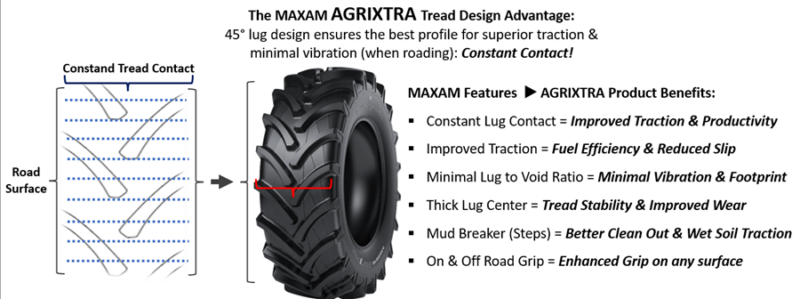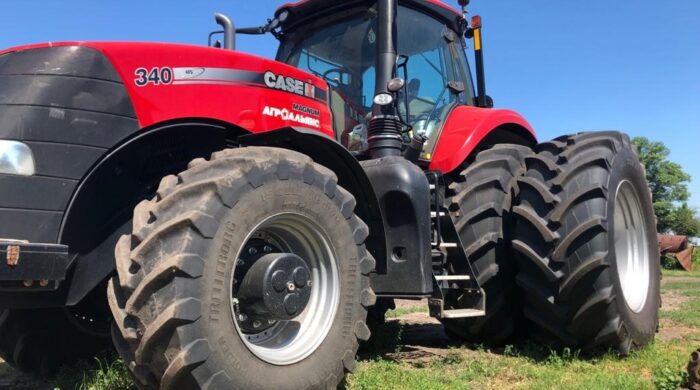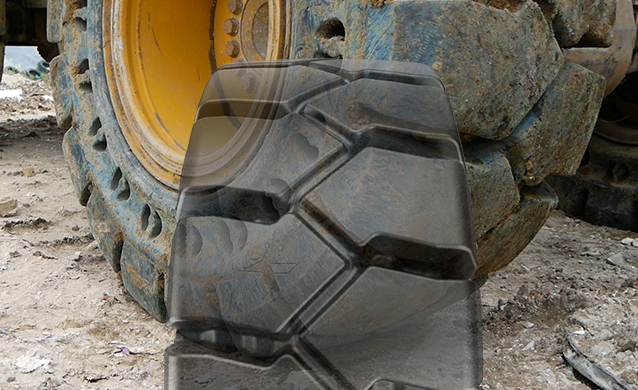On Large AG Equipment, why is continuous angle 45-degree lug so popular, are there applications you recommend a lower or higher degree angle, or multi-angle lug design, and are there specific applications you recommend departure from traditional lug design to improve performance?
When reviewing tire tread designs for traction across various applications and surface conditions, the best traction available for any operation in softer soils or cropped fields would be a flat or horizontal traction bar like a military tank tread or tracked dozer. Unfortunately, the effect on ride, fuel efficiency, and slip rates quickly moved the agricultural industry to the traditional R-1 chevron design. Early tire tread designs adopted the 23° lug angle that improved the ride while ensuring good field traction and improved fuel efficiency.
The 45° lug concept was initiated by tire manufacturers in Europe as the tractor applications were significantly different than in North America. European applications demanded more time on the road, transporting to the market, or simply moving from the farm to the field in many cases towing implements or cargo. This application requirement in Europe pushed tire manufacturers to adopt the 45° angle chevron design for all powered machinery using R-1, R-1W, R-2, and even R-4 agro-industrial products. This design has become the industry standard as all agricultural tire manufacturers have adopted the 45° lug angle as the optimal design for core farming with both radial and bias ply constructed tires. From the smallest below 65 horsepower machinery to the latest +700 horsepower machinery rolling off the OEM production lines, the 45° lug radial chevron tread from R-1 to R-4’s is leading the product performance expectation to deliver the value that farmers and growers are seeking in their tires.
The MAXAM radial agricultural product offer is centered on our AGRIXTRA tread design that is uniformly standardized across all our standard and VF R-1/R-1W tires. The 45° lug bar allows MAXAM’s agricultural tires to deliver improved traction, stability, endurance, and improved wear. Listed below are the key elements of our AGRIXTRA tread design and the benefits of our engineered features:
MAXAM’s AGRIXTRA tread design ensures optimal traction and performance for both on the road and off the road/in the field performance without compromising the capability of the tire to carry the load at any given speed. As listed above, the key features incorporated in our lug design are each geared to convey a specific benefit that will ensure the AGRIXTRA delivers the value and tread life that farmers or growers are seeking.
Beyond the field work environment that requires the efficient transmission of the machine engine torque and flotation, the growing market evolution is requiring that agricultural tires deliver the performance traditionally expected of automobile as crops are harvested and brought to market by a tractor. As agricultural machinery continues to grow in weight, engine horsepower, and transmitted torque, the tread design coupled with the growing need for IF & VF technology is rewriting the rules. This gives the structural components of the tire a larger impact on the performance and value the tire must deliver. Therefore, IF and VF technology tires perform at top-tier rates when coupled with the 45° lug tread designs, delivering the load, speed, heat resistance, and endurance that is demanded both now and for the years to come.
Beyond the use of the 45° Lug design with or without improved materials such as IF or VF construction, we are seeing more modified tread designs that increase the contact area of the tires. By increasing the width of the lugs or by reducing the void to lug ratio areas by adding more lugs in the traditional void area, IF and VF technology can increase the contact patch. This is specifically occurring in agro-industrial applications that may include the use of utility tractors, mower tractors, backhoes, compact wheel loaders, and telehandlers. We are seeing the evolution of the R-1 tread design beyond the 45° lug concept from the traditional chevron tread design to a multi-purpose or MPT tread design that emphasizes more rubber contact or additional lugs in the void areas. The goal of these modern designs is to deliver just enough traction to ensure the soil conditions can be met while delivering more contact area. This results in a higher tread endurance required of harder or more demanding surfaces historically reserved for more robust construction application-oriented tires or tread designs. What is clear is that the concept of the 45° lug on R-1 to R-4 tires even with more lugs like the evolving MPT tread concept has successfully met the market need for traction, constant contact, and machine productivity.
MAXAM has developed the AGRIXTRA family of R-1 and R-1W tires to meet the global requirements of the ag market. Our AGRIXTRA product range has been engineered to ensure the optimal contact patch without compromising the steering, flotation, traction, or torque transfer capability of the tire. MAXAM will be developing additional VF and MPT tires in the coming years to meet the evolving global demand for higher load, platform, or market technological changes. In addition, MAXAM will also employ our new Ecopoint3 rubber compound technology to rewrite the tire endurance rules and deliver value-centered products that will exceed OEM and both farmer or grower expectations.




